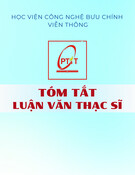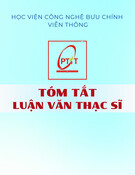
MINISTRY OF EDUCATION
AND TRAINING
VIETNAM ACADEMY
OF SCIENCE AND TECHNOLOGY
GRADUATE UNIVERSITY SCIENCE AND TECHNOLOGY
…………***…………
VU THI THU LE
RESEARCH ON CHEMICAL CONSTITUENTS AND
BIOLOGICAL ACTIVITIES OF CALLICARPA CANDICANS AND
CALLICARPA MACROPHYLLA GROWING IN VIETNAM
Major: Chemistry of natural compounds
Code: 9.44.01.17
SUMMARY OF CHEMICAL DOCTORAL THESIS
HA NOI - 2020

This thesis was completed at Graduate University of Science and Technology
- Vietnam Academy of Science and Technology.
Supervisors:
1. Assoc.Prof. Dr. Pham Thi Hong Minh
Institute of Natural Products Chemistry – Vietnam Academy of Science
and Technology
2. Prof. Dr. Pham Quoc Long
Institute of Natural Products Chemistry – Vietnam Academy of Science
and Technology
Examiner 1: Assoc.Prof. Dr. Phan Minh Giang
University of Science – Vietnam National University
Examiner 2: Dr. Đỗ Hữu Nghị
Institute of Natural Products Chemistry – Vietnam Academy of
Science and Technology
The thesis defense was monitored by the Graduate University level Board
of Examiners, held at: Graduate University of Science and Technology - 18
Hoang Quoc Viet - Cau Giay - Ha Noi.
At ……….. , ….………………….. 2020

The thesis is available in Vietnam National Library and Library of Graduate
University of Science and Technology.

1
PREAMBLE
1. The urgency of the thesis
Vietnam is located in a tropical climate region with extremely rich natural
resources and biodiversity with many valuable medicinal herbs. The increasing
use of traditional medicinal herbs or from naturally occurring compounds has
taken an important position in medicine. Herbal remedies are the subject for
scientists to fully study the nature of the active ingredients in natural plants, the
results of the study will contribute to a better explanation of the effects.
Treatment of traditional medicinal plants is still often used in folk.
In the world, studies of the genus Callicarpa mainly focus on: botanical,
pharmacology, plant chemistry and clinical. Pharmacological studies
conducted on crude extracts or pure compounds provide the scientific basis for
traditional use. Biological activity studies mainly focused on activities: anti-
inflammatory, hemostasis, memory loss, oxidation, antibacterial. Studies of
chemical composition and biological activity in the world show that
diterpenoid and triterpenoid compounds have very good anticancer activity,
which is the most abundant chemical component in Callicarpa genus.
The research to find out the active ingredients of plants has been receiving
the attention of scientists from many countries around the world, including
Vietnam. This is also the reason for the topic "Studying the chemical
composition and biological activity of the Sheic species (Callicarpa candicans)
and the large-leafed Tuzhou (Callicarpa macrophylla) in Vietnam." be selected
for research.
.
2. The research objectives of the thesis
Isolate and determine the chemical structure of compounds from C.
candicans and C. macrophylla species collected in Vietnam.
Assessment of toxic activity on some cancer cell lines: liver (Hep-G2), lung
(Lu-1) and breast (MCF-7) of isolated clean compounds.
Researching the chemical composition of C. candicans and C. macrophylla
essential oils.
3. The main research content of the thesis
1.Determining the chemical structure of compounds isolated from leaves of C.
candicans and C. macrophylla in Vietnam

2
2.Determining the essential chemical composition of leaves of C. candicans
and C. macrophylla in Vietnam by conventional steam entraining methods and
microwave-assisted distillation methods.
3.Evaluation of toxic activity on three cancer cell lines (liver - HepG2, prostate
- PC3, lung - A549) and in vitro antimicrobial testing of essential oils obtained
from C. candicans leaves and C. macrophylla.
4. Evaluation of toxic activity on three strains of liver cancer (Hep-G2), lung
(Lu-1) and breast (MCF-7) in vitro of clean compounds isolated
from leaves of C. candicans and C. macrophylla
Chapter 1. OVERVIEW
The literature review is a collection of national and international research on:
1.1. General characteristics of botany Callicarpa
1.2. Pharmacological effects of the genus Callicarpa
1.3. Chemical composition of plants genus Callicarpa
1.4. Biological activity of genus Callicarpa plants
Chapter 2. SUBJECTS AND METHODS OF THE STUDY
This section describes in detail the sample handling processes, the methods of
generating sediments, chromatography and the isolation of compounds;
determine the chemical composition of essential oils and methods of bioactive
test.
2.1. Materials and research methods
2.1.1. Plant samples
Leaves, stems, branches and fruits (Callicarpa candicans (Burm.f.) Hochr.)
And Tu Chau big leaves (Callicarpa macrophylla Vahl) collected in Tam Dao
district - Vinh Phuc in October 2015 and Dai Tu district, province Thai Nguyen
in October 2017, Dr. Nguyen Quoc Binh (Vietnam Museum of Nature - VAST)
identifies the scientific name and denominator model stored at the Vietnam
Museum of Nature.
2.1.2. Method of isolation of compounds from tree samples
The analysis and separation of plant extracts are made by different chromatographic






![Luận văn Thạc sĩ: Tổng hợp và đánh giá hoạt tính chống ung thư của hợp chất lai chứa tetrahydro-β-carboline và imidazo[1,5-a]pyridine](https://cdn.tailieu.vn/images/document/thumbnail/2025/20250807/kimphuong1001/135x160/50321754536913.jpg)



















